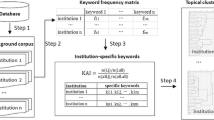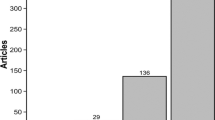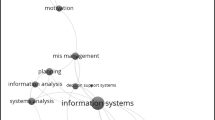Abstract
Novelty and salience of the research topics are vital for the competitiveness of research institutions and the development of science and technology. In this study, two novel weighting methods were proposed to differentiate the emergence and salience of research topics. A methodology was constructed to measure and visualize the contributions of research institutions to emerging themes and salient ones. The methods were illustrated with the data of ninety Chinese and American Library and Information Science research institutions collected from the Engineering Compendex and China National Knowledge Infrastructure databases between 2001 and 2012. The contributions of the investigated research institutions to the emerging themes and salient ones were calculated and visualized with the Treemap technique. The institutions were further ranked by their contributions and categorized into four types. The findings can help research institutions evaluate novelty and salience of their research topics, discover research fronts and hotspots and promote their research development.




Similar content being viewed by others
References
An, L., & Li, G. (2010). Research on salient subjects and their developing trends of foreign library and information science journals. New Technology of Library and Information Service, 26(9), 48–55.
An, L., Yu, C., & Li, G. (2014). Visual topical analysis of Chinese and American Library and Information Science research institutions. Journal of Informetrics, 8(1), 217–233.
Apply to join iSchools. (2015). Obtained at http://ischools.org/members/apply-to-join/. Accessed January 18, 2015.
Asahi, T., Turo, D., & Shneiderman, B. (1995). Using Treemaps to visualize the analytic hierarchy process. Information Systems Research, 6(4), 357–375.
Bederson, B. B., Shneiderman, B., & Wattenberg, M. (2002). Orded and quantum Treemaps: Making effective use of 2D space to display hierarchies. ACM Transactions on Graphics, 21(4), 833–854.
Berg, M., Speckmann, B., & Weele, V. (2011). Treemaps with bounded aspect ratio. In Proceedings of the 22nd international symposium on algorithm analysis and computation, Yokohama, Japan, December 5–8, pp. 260–270.
Blank, C. D., Pottenger, W. M., Kessler, G. D., Herr, M., Jaffe, H., Roy, S., et al. (2001). CIMEL: Constructive, Collaborative inquiry-based multimedia e-learning. In Proceedings of the Sixth annual conference on innovation and technology in computer science education (ITiCSE), Jun 2001.
Blei, D. M., & Lafferty, J. D. (2006). Dynamic topic models. In Proceedings of the 23rd international conference on machine learning (ICML’06). ACM, New York, pp. 113–120.
Blei, D. M., & Lafferty, J. D. (2007). A correlated topic model of science. Annals of Applied Statistics, 1(1), 17–35.
Bruls, M., Huizing, K., & van Wijk, J. J. (2000). Squarified treemaps. In W. de Leeuw & R. van Liere (Eds.), Data visualization 2000: proceedings of joint eurographics and IEEE TCVG symposium on visualization (pp. 33–42). Berlin/Heidelberg: Springer.
Bruns, A., Burgess, J., Highfield, T., Kirchhoff, L., & Nicolai, T. (2011). Mapping the Australian Networked Public Sphere. Social Science Computer Review, 29(3), 277–287.
Cataldi, M., Caro, L. D., & Schifanella, C. (2013). Personalized emerging topic detection based on a term aging model. ACM Transactions on Intelligent Systems and Technology, 5(1), 1–27.
Chen, C. (2006). CiteSpace II: Detecting and visualizing emerging trends and transient patterns in scientific literature. Journal of the American Society for Information Science and Technology, 57(3), 359–377.
Chen, C. (2013). Mapping scientific frontiers: The quest for knowledge visualization (2nd ed.). London: Springer.
CNKI. (2014). Obtained at http://ec.cnki.net/cp&fw.html. Accessed December 2, 2014.
Engineering Village. (2013). Obtained at http://www.engineeringvillage.com/controller/servlet/Controller?CID=quickSearch&database=1. Accessed January 5, 2013.
Fan, Y., & Ma, J. (2012). Review on the LDA-based techniques detection for the field emerging topic. New Technology of Library and Information Service, 12, 58–65.
Fan, Y., Ma, J., & Zeng, S. (2013). The analysis of the studies on the field emerging topics based on knowledge mapping. Journal of Intelligence, 32(9), 88–94.
Fischer, F., Fuchs, J., & Mansmann, F. (2012). ClockMap: Enhancing circular Treemaps with temporal glyphs for time-series data. In Proceedings of eurographics conference on visualization, pp. 97–101.
Glänzel, W., & Thijs, B. (2012). Using ‘core documents’ for detecting and labelling new emerging topics. Scientometrics, 91(2), 399–416.
Good, L., Popat, A. C., Janssen, W. C., & Bier, E. (2005). A fluid treemap interface for personal digital libraries. Research and Advanced Technology for Digital Libraries, 3652, 162–173.
Griffith, D. A., Cavusgil, S. T., & Xu, S. (2008). Emerging themes in international business research. Journal of International Business Studies, 39(7), 1220–1235.
Havre, S., Hetzler, E., Whitney, P., & Nowell, L. (2002). ThemeRiver: Visualizing thematic changes in large document collections. IEEE Transactions on Visualization and Computer Graphics, 8(1), 9–20.
Horn, M. S., Tobiasz, M., & Shen, C. (2009). Visualizing biodiversity with Voronoi Treemaps. In Proceedings of sixth annual international symposium on Voronoi diagrams in science and engineering, June 23–26, Copenhagen, Denmark.
Hou, S., Tang, J., Zhu, Y., & Yu, F. (2013). The “change” and “constant” of library and information science in 2000–2011: A case of library and information service. Library and Information Service, 57(10), 25–32.
iSchools Directory. (2015). Obtained at http://ischools.org/members/directory/. Accessed January 3, 2015.
Khan, M. S., Coenen, F., Reid, D., Patel, R., & Archer, L. (2010). A sliding windows based dual support framework for discovering emerging trends from temporal data. Knowledge Based Systems, 23(4), 316–322.
Kontostathis, A., Galitsky, L. M., Pottenger, W. M., Roy, S., & Phelps, D. J. (2004). A survey of emerging trend detection in textual data mining. In M. W. Berry (Ed.), Survey of text mining (pp. 185–224). New York: Springer.
Lai, M., Wang, L., & Li, Y. (2008a). Survey and analysis of the frontiers in information science. Library and Information Service, 52(3), 6–10.
Lai, M., Wang, L., Yang, W., & Li, Y. (2008b). The research frontiers of information science: Identification and discussion. Library and Information Service, 52(3), 15–18.
Lee, W. H. (2008). How to identify emerging research fields using scientometrics: An example in the field of Information Security. Scientometrics, 76(3), 503–525.
Lent, B., Agrawal, R., & Srikant, R. (1997). Discovering trends in text database. In Proceedings of knowledge discovery and data mining (KDD-97), pp. 227–230.
Macrofocus. (2013). Treemap. Obtained at http://www.treemap.com/. Accessed April 10, 2013.
Malcolm, C., Knighting, K., Forbatm, L., & Kearney, N. (2009). Prioritisation of future research topics for children’s hospice care by its key stakeholders: A Delphi study. Palliative Medicine, 23(5), 398–405.
Marghescu, D. (2007). User evaluation of multidimensional data visualization techniques for financial benchmarking. In Proceedings of the European conference on information management and evaluation, pp. 341–356.
Ministry of Education. (2012). Catalog of undergraduate majors in universities and colleges. Obtained at http://www.moe.gov.cn/ewebeditor/uploadfile/2012/10/12/20121012084054830.doc. Accessed January 6, 2013.
Moed, H. F., Moya-Anegón, F., López-Illescas, C., & Visser, M. (2011). Is concentration of university research associated with better research performance? Journal of Informetrics, 5(4), 649–658.
Piwowarski, B., Amini, M. R., & Lalmas, M. (2012). On using a quantum physics formalism for multidocument summarization. Journal of the American Society for Information Science and Technology, 63(5), 865–888.
Porter, A. L., & Detampel, M. J. (1995). Technology opportunities analysis. Technological Forecasting and Social Change, 49(3), 237–255.
Qiu, J., Wang, X., & Wang, B. (Eds.). (2011). Evaluation report on Chinese graduate education and disciplines. Research center for china science evaluation. Beijing: Kexue Press.
Rios-Berrios, M., Sharma, P., Lee, T. Y., Schwartz, R., & Shneiderman, B. (2012). TreeCovery: Coordinated dual treemap visualization for exploring the Recovery Act. Government Information Quarterly, 29(2), 212–222.
Rojas, W. A. C., & Villegas, C. J. M. (2013). Graphical representation and exploratory visualization for decision trees in the KDD Process. In Proceedings of the 2nd international conference on integrated information (IC-ININFO 2012), Budapest, Hungary, August 30–September 3, 2012, Vol. 73, pp. 136–144.
Schult, R., & Spiliopoulou, M. (2006). Discovering emerging topics in unlabelled text collections. Advances in Databases and Information Systems, 4152, 353–366.
Shneiderman, B., & Wattenberg, M. (2001). Ordered Treemap layouts. In Proceedings of the IEEE symposium on information visualization, San Diego, October 22–23, 2001.
Small, H. (2006). Tracking and predicting growth areas in science. Scientometrics, 68(3), 595–610.
Takahashi, T., Tomioka, R., & Yamanishi, K. (2014). Discovering emerging topics in social streams via link-anomaly detection. IEEE Transactions on Knowledge and Data Engineering, 26(1), 120–130.
US News & World Report. (2011). Best graduate school-library and information studies. Obtained at http://grad-schools.usnews.rankingsandreviews.com/best-graduate-schools/search.result/program+top-library-information-science-programs/top-library-information-science-programs+y. Accessed January 15, 2013.
Vliegen, R., van der Linden, E., & vanWijk, J. J. (2006). Visualizing business data with generalized Treemaps. IEEE Transactions on Visualization and Computer Graphics, 12(5), 789–796.
Wallach, H. M. (2006). Topic modeling: Beyond bag-of-words. In Proceedings of the 23rd international conference on machine learning (ICML’06). ACM, New York, pp. 977–984.
Wang, W., Wang, L., & Zhu, H. (2010). Research frontier and hot spots analysis of international informetrics. Journal of Medical Informatics, 31(2), 1–4, 25.
Wareham, J. D., Busquets, X., & Austin, R. D. (2009). Creative, convergent, and social: Prospects for mobile computing. Journal of Information Technology, 24(2), 139–143.
Wattenberg, M. (2005). A note on space-filling visualizations and space-filling curves. In IEEE symposium on information visualization, October 23–25, 2005, pp. 181–186.
Wei, J., & Wei, H. (2011). The analysis of hot topics on digital library by CiteSpace II. Library Journal, 30(4), 70–88.
Winston, A. M. (2014). Law firm knowledge management: A selected annotated bibliography. Law Library Journal, 106(2), 175–197.
Xiao, M., Chen, J., & Li, G. (2011). Visual analysis of the research on mapping knowledge domains based on CiteSpace. Library and Information Service, 55(6), 91–95.
Yang, W., Zhang, L., Li, L., & Du, X. (2008). Research frontiers of information science: A document-based survey. Library and Information Service, 52(3), 11–14.
Zhang, Q., & Ma, F. (2007). On paradigm of research knowledge management: A bibliometric analysis. Journal of Management Sciences in China, 12(6), 65–75.
Zhou, J. (2011). Document visualization analysis of information visualization based on the CiteSpace II. Information Science, 29(1), 98–101.
Acknowledgments
We thank the National Social Science Foundation of China (11CTQ025), National Natural Science Foundation of China (71373286) and the China Scholarship Council for financial support. We are also grateful to Qingling Pan, Li Dong and Jiajia Qin for collecting the controlled terms and keywords of the publications by the Chinese and American LIS research institutions in this study. Many thanks go to the anonymous peer reviewer for his or her invaluable suggestion on the revision of this article.
Author information
Authors and Affiliations
Corresponding author
Rights and permissions
About this article
Cite this article
An, L., Lin, X., Yu, C. et al. Measuring and visualizing the contributions of Chinese and American LIS research institutions to emerging themes and salient themes. Scientometrics 105, 1605–1634 (2015). https://doi.org/10.1007/s11192-015-1640-4
Received:
Published:
Issue Date:
DOI: https://doi.org/10.1007/s11192-015-1640-4




